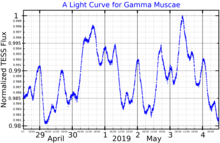
| |
| Observation data Epoch J2000.0 Equinox J2000.0 | |
|---|---|
| Constellation | Musca |
| Right ascension | 12 32 28.01343 |
| Declination | −72° 07′ 58.7597″ |
| Apparent magnitude (V) | 3.87 |
| Characteristics | |
| Spectral type | B5 V |
| U−B color index | −0.61 |
| B−V color index | −0.15 |
| Variable type | SPB |
| Astrometry | |
| Radial velocity (Rv) | 2.5±7.4 km/s |
| Proper motion (μ) | RA: −51.34 mas/yr Dec.: −5.40 mas/yr |
| Parallax (π) | 10.04 ± 0.13 mas |
| Distance | 325 ± 4 ly (100 ± 1 pc) |
| Absolute magnitude (MV) | −1.1 |
| Details | |
| Mass | 5.09 M☉ |
| Radius | 4.17 R☉ |
| Luminosity | 790 L☉ |
| Surface gravity (log g) | 3.87 cgs |
| Temperature | 15,490 K |
| Rotational velocity (v sin i) | 205 km/s |
| Age | 67.7 Myr |
| Other designations | |
| β Vol, CD−70°997, FK5 487, GC 17672, HD 109026, HIP 61199, HR 4773, SAO 257000 | |
| Database references | |
| SIMBAD | data |
γ Muscae, Latinised as Gamma Muscae, is a blue-white hued star in the southern circumpolar constellation of Musca, the Fly. It can be seen with the naked eye, having an apparent visual magnitude of 3.87. Based upon an annual parallax shift of 10.04 mas as seen from Earth, it is located about 325 light years from the Sun.

This is a B-type main-sequence star with a stellar classification of B5 V. It is a variable star that ranges between magnitudes 3.84 and 3.86 over a period of 2.7 days, and is classed as a slowly pulsating B star. It is around five times as massive as the Sun. The star is spinning rapidly with a projected rotational velocity of 205 km/s. This is giving it an oblate shape with an equatorial bulge that is 7% larger than the polar radius.
Gamma Muscae is a proper motion member of the Lower Centaurus–Crux sub-group in the Scorpius–Centaurus OB association, the nearest such association of co-moving massive stars to the Sun.
References
- ^ van Leeuwen, F. (November 2007), "Validation of the new Hipparcos reduction", Astronomy and Astrophysics, 474 (2): 653–664, arXiv:0708.1752, Bibcode:2007A&A...474..653V, doi:10.1051/0004-6361:20078357, S2CID 18759600.
- ^ Johnson, H. L.; et al. (1966), "UBVRIJKL photometry of the bright stars", Communications of the Lunar and Planetary Laboratory, 4 (99): 99, Bibcode:1966CoLPL...4...99J.
- ^ van Belle, Gerard T. (March 2012), "Interferometric observations of rapidly rotating stars", The Astronomy and Astrophysics Review, 20 (1): 51, arXiv:1204.2572, Bibcode:2012A&ARv..20...51V, doi:10.1007/s00159-012-0051-2, S2CID 119273474.
- ^ Gontcharov, G. A. (November 2006), "Pulkovo Compilation of Radial Velocities for 35495 Hipparcos stars in a common system", Astronomy Letters, 32 (11): 759–771, arXiv:1606.08053, Bibcode:2006AstL...32..759G, doi:10.1134/S1063773706110065, S2CID 119231169.
- ^ de Geus, E. J.; et al. (June 1989), "Physical parameters of stars in the Scorpio-Centaurus OB association", Astronomy and Astrophysics, 216 (1–2): 44–61, Bibcode:1989A&A...216...44D.
- ^ Glagolevskij, Yu. V. (January 2019), "On Properties of Main Sequence Magnetic Stars", Astrophysical Bulletin, 74 (1): 66–79, Bibcode:2019AstBu..74...66G, doi:10.1134/S1990341319010073, S2CID 255384587. Vizier-4
- ^ MAST: Barbara A. Mikulski Archive for Space Telescopes, Space Telescope Science Institute, retrieved 23 September 2022.
- ^ BSJ (5 March 2012), "Gamma Muscae", AAVSO Website, American Association of Variable Star Observers, retrieved 21 December 2013.
- ^ Molenda-Zakowicz, J.; Połubek, G. (2004), "Empirical absolute magnitudes, luminosities and effective temperatures of SPB variables and the problem of variability classification of monoperiodic stars", Acta Astronomica, 54: 281–97 , Bibcode:2004AcA....54..281M.
| Constellation of Musca | |||||||||||
|---|---|---|---|---|---|---|---|---|---|---|---|
| Stars |
| ||||||||||
| |||||||||||
| |||||||||||
| Nebulae |
| ||||||||||